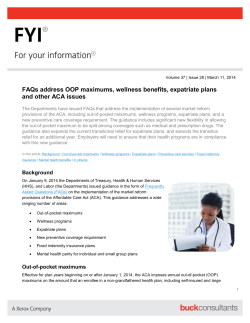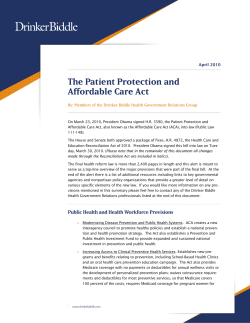
February 10, 2014
Issue Eighty-One February 2014 February 10, 2014 The Departments of Labor (DOL), Health and Human Services (HHS) and Treasury (collectively called the Departments) recently released a set of Frequently Asked Questions (FAQs). These FAQs address practical implementation issues related to the Affordable Care Act (ACA) and the Mental Health Parity and Addiction Equity Act (MHPAEA). These FAQs cover implementation issues related to: Coverage of preventive care services Maximum out-of-pocket limits on cost-sharing Expatriate health plans Wellness programs Fixed indemnity insurance Mental Health Parity and Addiction Equity Act This Reform Update will review these FAQs. Coverage of Preventive Care Services One aspect of the ACA requires non-grandfathered health plans to cover specified preventive care services without member cost-sharing. The list of services is determined by the recommendations of several government organizations, including the United States Preventive Services Task Force (USPSTF). On September 24, 2013, the USPSTF issued a new recommendation regarding medications that reduce the risk of breast cancer in women, stating: The USPSTF recommends that clinicians engage in shared, informed decision making with women who are at increased risk for breast cancer about medications to reduce their risk. For women who are at increased risk for breast cancer and at low risk for adverse medication effects, clinicians should offer to prescribe risk-reducing medications, such as tamoxifen or raloxifen. As a result of this recommendation, non-grandfathered health plans will need to cover these medications with no cost-sharing for women at increased risk for breast cancer. The ACA allows health plans one year to amend coverage for changes in relation to preventive services recommendations. As a result, health plans will have until the first day of the first plan year beginning on or after September 24, 2014 to add this coverage without member cost-sharing. McGraw Wentworth www.mcgrawwentworth.com Issue Eighty-One February 2014, Page 2 Maximum Out-of-Pocket Limits on Cost-Sharing As of the first day of the first plan year beginning on or after January 1, 2014, non-grandfathered health plans will be subject to maximum out-of-pocket cost limits. In 2014, the out-of-pocket maximums are $6,350 for single coverage and $12,700 for family coverage. A previous FAQ provided additional time to comply when a health plan or insurer uses more than one service provider to administer benefits subject to the maximum out-of-pocket limit. In order to have an additional year to comply, the plan had to satisfy the following: The plan had to comply with the maximum out-of-pocket limits with respect to its major medical coverage. To the extent that the plan or any health insurance coverage includes an out-of-pocket maximum and the plan does not consist solely of major medical benefits, the maximum cannot exceed the statutory limits noted above. The new FAQs offer more details on the maximum out-of-pocket limit. The following issues are addressed: As of the first day of the first plan year beginning on or after January 1, 2015, nongrandfathered group health plans will need to make sure the out-of-pocket maximum on essential health benefits (EHBs) does not exceed the statutory maximum. Maximums are indexed annually. States designate EHBs. The Departments recognize that it may be difficult for self-funded plans and large group insured plans to understand precisely what constitutes EHBs. The Departments will use enforcement discretion with plans that make a good faith effort to determine essential health benefits. Remember, in 2014 and 2015, large group health plans can either be 50 or 100 or more employees. By 2016, all states will define large groups as 100 or more employees. Health plans with multiple service providers may find it easier to divide the annual out-ofpocket limit across multiple categories of benefits. It is difficult to set up data exchanges among service providers that would allow all out-of-pocket costs to accumulate toward a single maximum. These FAQs make clear that separate out-of-pocket maximums may be used, as long as they do not exceed the statutory limit when added together. For example, it is not uncommon for an employer to insure the major medical benefits and to carve out and self-fund the prescription drug benefits. In that case, a plan could set a single out-of-pocket maximum of $4,000 on major medical benefits and a separate $2,000 maximum on prescription drug benefits. Since the two limits do not exceed the statutory maximum out-of-pocket limit, this would be permitted. A plan is not required to count the member cost-sharing for out-of-network services toward the plan’s out-of-pocket maximum limit. A plan is not required to count out-of-pocket spending for non-covered services towards the plan’s out-of-pocket maximum limit. The ACA defines cost-sharing as: - Deductibles, coinsurance, copayments or similar charges and - Any other expenditure required of an individual which is a qualified medical expense with respect to an essential health benefit covered by the plan McGraw Wentworth www.mcgrawwentworth.com Issue Eighty-One February 2014, Page 3 Cost-sharing does not include premiums, balance-billing for non-participating providers or spending for non-covered services. These clarifications should assist employers in planning for 2015. Expatriate Health Plans In a previous FAQ, expatriate plans were granted additional time to comply with the following aspects of the ACA: Medical plan eligibility for adult children to age 26 Prohibitions on lifetime and annual dollar limits on essential health benefits Prohibition on coverage rescissions Elimination of pre-existing condition exclusions for all enrollees Summary of Benefits and Coverage and uniform glossary, as well as 60-day advance notice of material modifications Medical loss ratio requirements Preventive services covered without participant cost-sharing Prohibition on discrimination in favor of highly compensated employees under insured medical plans (if/when effective) PPACA internal claims and appeals and external review requirements Patient protections (i.e. coverage for out-of-network emergency care services, right to designate primary care provider, direct access to OB/GYN) Prohibition on waiting periods in excess of 90 days Annual in-network out-of-pocket maximum of no greater than the health savings accountqualifying high-deductible health plan limits ($6,350 for self-only coverage/$12,700 for family coverage in 2014) Coverage for individuals participating in approved clinical trials Transitional reinsurance fee These plans are excused from these requirements until the first plan year that begins on or after January 1, 2016. This set of FAQs provides more details on expatriate health plans: For the purposes of temporary transitional relief, an insured expatriate plan is an insured plan in which eligibility is limited to individuals where there is a good faith expectation that they will reside outside their home country, or outside the United States, for at least six months of a 12-month period. The coverage can be extended to dependents. Coverage under an expatriate plan will generally be considered minimum essential coverage. McGraw Wentworth www.mcgrawwentworth.com Issue Eighty-One February 2014, Page 4 The Departments intend to issue tailored guidance to address insured expatriate plans. The Departments intend that any new regulation that is more restrictive will not be applicable to plan years ending on or before December 31, 2016. Wellness Programs One of the changes introduced by the ACA included the ability to increase incentives for healthcontingent wellness plans. The details of the final regulations are reviewed in our Reform Update at http://www.mcgrawwentworth.com/Reform_Update/2013/Reform_Update_68.pdf. These FAQs provide additional details on these final regulations: One question outlines a situation where an employer charges participants who use tobacco a surcharge for medical coverage. The employer offers tobacco users the opportunity to avoid the surcharge if they agree to participate in and complete a tobacco cessation program. The employee needs to agree to participate in the plan at open enrollment. One employee who uses tobacco declines to participate in the program at open enrollment, but decides to join the tobacco cessation program mid-year. Is the employer obligated to allow the employee to avoid the surcharge or to provide another reward? No, the rules only require that the plan offer an individual the opportunity to earn the reward annually. The employee was offered the opportunity at the beginning of the plan year. The plan will have to offer the opportunity again during the next open enrollment. Although an employer can offer the reward mid-year, it is not required. Another question addresses a situation where a participant’s doctor advises that an outcomes-based wellness plan’s standard for obtaining a reward is medically inappropriate for the participant. The doctor recommended a weight reduction program that is activity-based instead. Does the plan have the ability to choose the activity-based program? The plan has the obligation to provide a reasonable alternative standard that accommodates the recommendations of the personal physician. In this situation, a number of activity-based programs may meet the physician’s recommendations. The plan and the participant can work together to determine the best alternative for the participant. The final question addresses the sample language, provided in the final regulations, which discloses the availability of an alternative standard. Can plans modify this language? Plans can modify the language as long as it is substantially similar to the sample language. Plans can provide more details about the alternative standards, but it is not required. These questions and answers should help employers with designing reasonable alternative standards for outcomes-based wellness programs. McGraw Wentworth www.mcgrawwentworth.com Issue Eighty-One February 2014, Page 5 Fixed Indemnity Insurance Fixed indemnity plans are generally considered excepted benefits and not subject to many of the requirements of the ACA. The Departments have noticed a significant increase in the number of policies that are being filed as fixed indemnity insurance. Previous guidance reiterated that in order for a fixed indemnity plan to be considered excepted, it must pay on a per-period basis. A policy that pays on a per-service basis would not be considered excepted. One FAQ provides insight on whether a fixed indemnity plan that pays benefits on other than a perperiod basis may qualify as an excepted benefit in another way. If a policy does not meet the requirements to be considered a fixed indemnity policy, it may still be an excepted benefit if it is considered a “supplemental” benefit. The requirements to be considered a supplemental benefit are found in the DOL’s Field Assistance Bulletin at http://www.dol.gov/ebsa/pdf/fab2007-4.pdf. In addition, HHS proposes to amend the excepted benefit regulations to allow a fixed indemnity policy to be considered an excepted benefit if it meets the following: 1. It is sold only to individuals who have other health insurance coverage that is considered minimum essential coverage. 2. There is no coordination between the provision of benefits and an exclusion of benefits under any other health coverage. 3. The benefits are paid in a fixed dollar amount, regardless of the amount of expenses incurred or the amount of benefits provided by any other health coverage for a covered service. 4. The plan materials include a notice informing policyholders that the coverage does not meet the definition of minimum essential coverage. It will therefore not satisfy the requirement to secure health coverage under the individual mandate. If these proposed requirements are adopted, individual fixed-indemnity policies would no longer have to pay benefits solely on a per-period basis to qualify as excepted. Until these proposed rules are finalized, HHS will treat fixed indemnity policies as excepted if they meet the above requirements. Mental Health Parity and Addiction Equity Act In November 2013, the Departments published final Mental Health Parity and Addiction Equity Act (MHPAEA) regulations. These FAQs clarify how the MHPAEA rules interact with the requirements of the ACA. The MHPAEA requires mental health and substance abuse services to be covered in parity with medical and surgical services. It does not require that plans cover mental health and substance abuse services. If plans do cover such services, then they must meet the parity requirements. The MHPAEA interacts with the essential health benefits requirements of the ACA. The EHB requirement is effective as of the first day of the first plan year beginning on or after January 1, 2014. Individual and small group insured plans must comply with EHBs. Keep in mind that a small group is defined by the state, and can be either fewer than 50 or fewer than 100 full-time employees. Mental health and substance abuse treatment benefits are considered EHBs. Certain plans will be required by the ACA to cover these services. If they are covered, it must be done in parity with the medical and surgical services. McGraw Wentworth www.mcgrawwentworth.com Issue Eighty-One February 2014, Page 6 The FAQs recap how certain plans are affected: Non-grandfathered individual market coverage: For policy years beginning on or after January 1, 2014, all non-grandfathered individual market coverage must include coverage for mental health and substance use disorder benefits. The mental health and substance abuse coverage must comply with the MHPAEA. The final MHPAEA rules apply to policy years beginning on or after July 1, 2014. Calendar-year policies must comply with the final MHPAEA rules by January 1, 2015. Grandfathered individual market coverage: Grandfathered individual health insurance coverage is not required to comply with the EHB requirements. These plans are not required to cover mental health or substance use disorder benefits. If the plan does cover mental health or substance use disorder services, coverage must comply with the final MHPAEA regulations as of the first day of the first policy year beginning on or after July 1, 2014. Non-grandfathered small group market coverage: Non-grandfathered small group market plans must cover mental health and substance abuse services. The coverage must comply with the final MHPAEA regulations as of the first day of the first plan year beginning on or after July 1, 2014. Grandfathered small group market coverage: Grandfathered small group coverage is not required to comply with either the EHB provisions or the MHPAEA. Concluding Thoughts These FAQs provide practical guidance on implementation issues facing employers as a result of the ACA. The government will likely continue to publish FAQs providing additional clarification. McGraw Wentworth www.mcgrawwentworth.com
© Copyright 2025





















